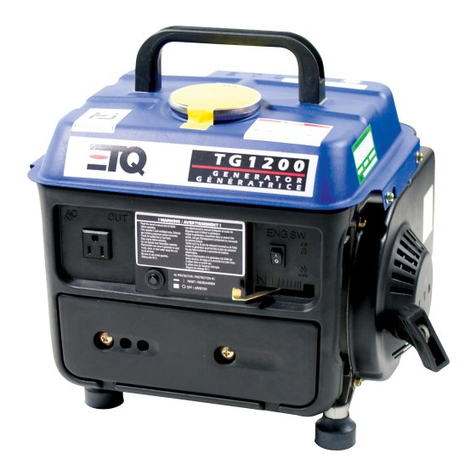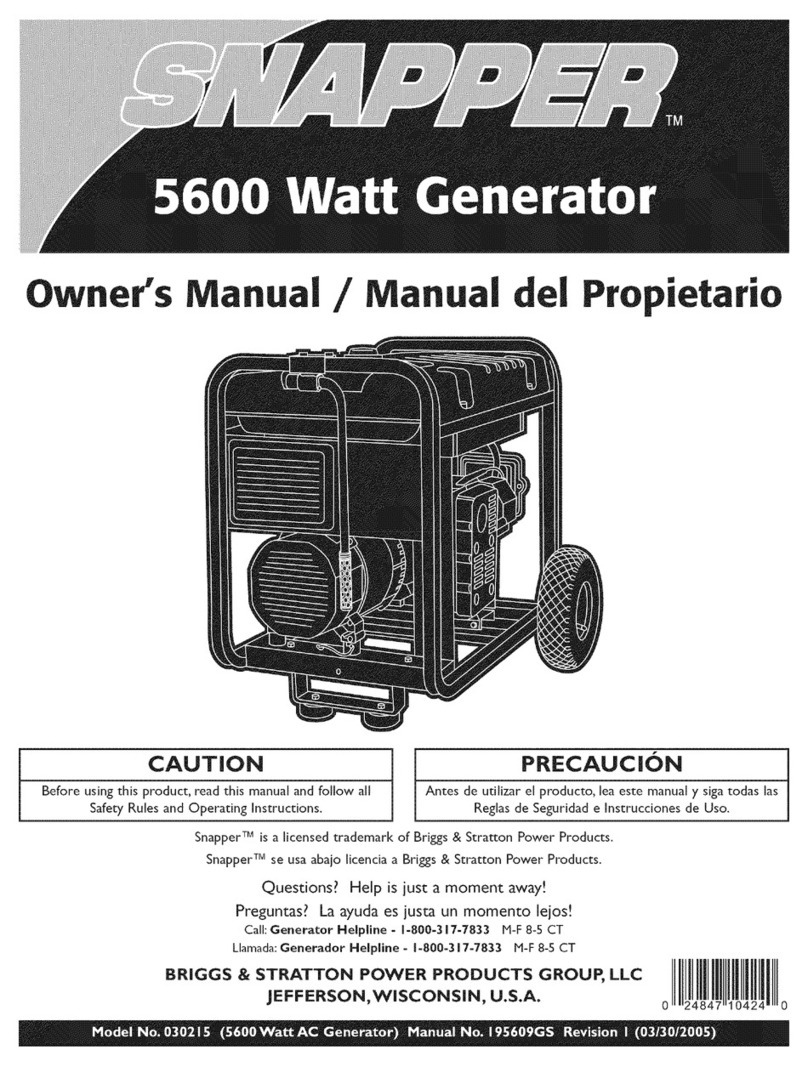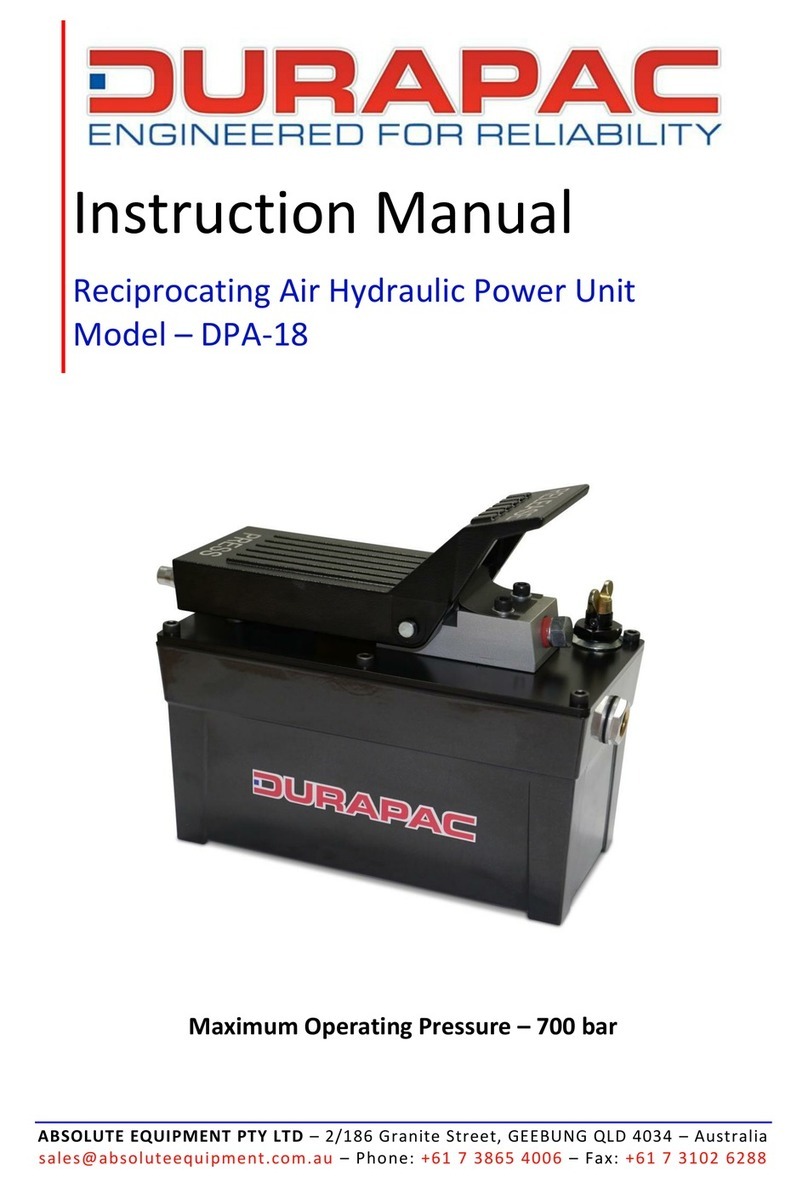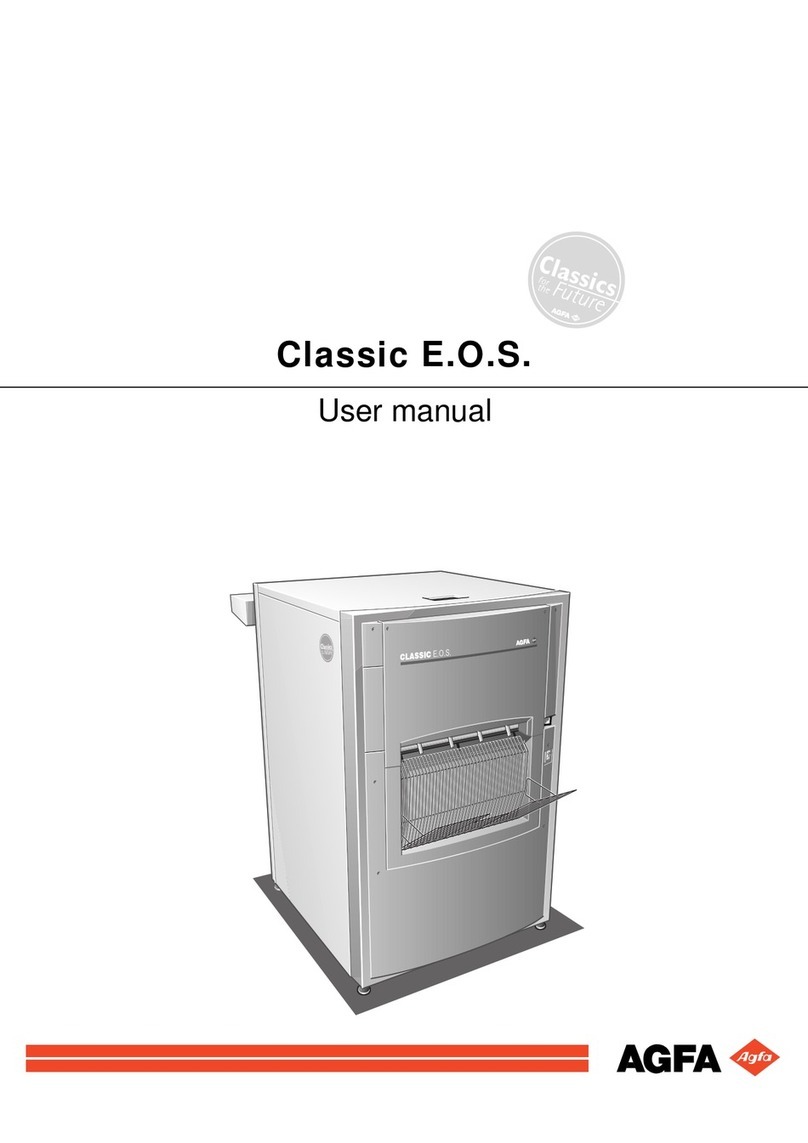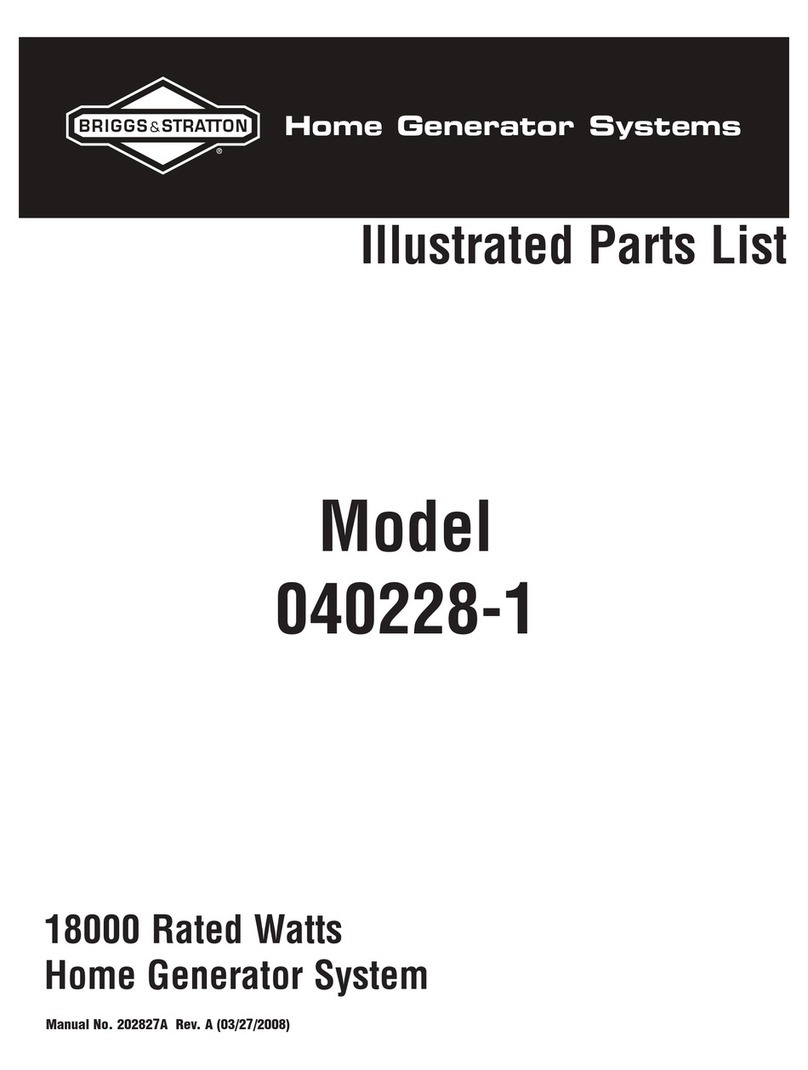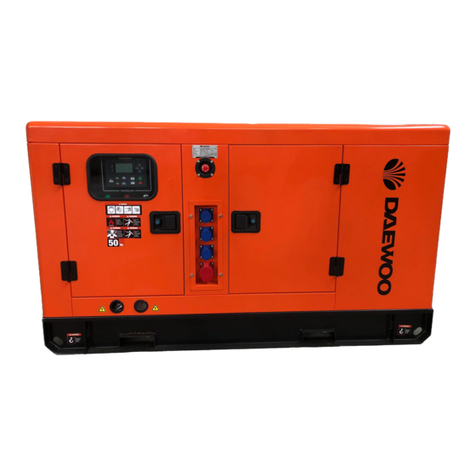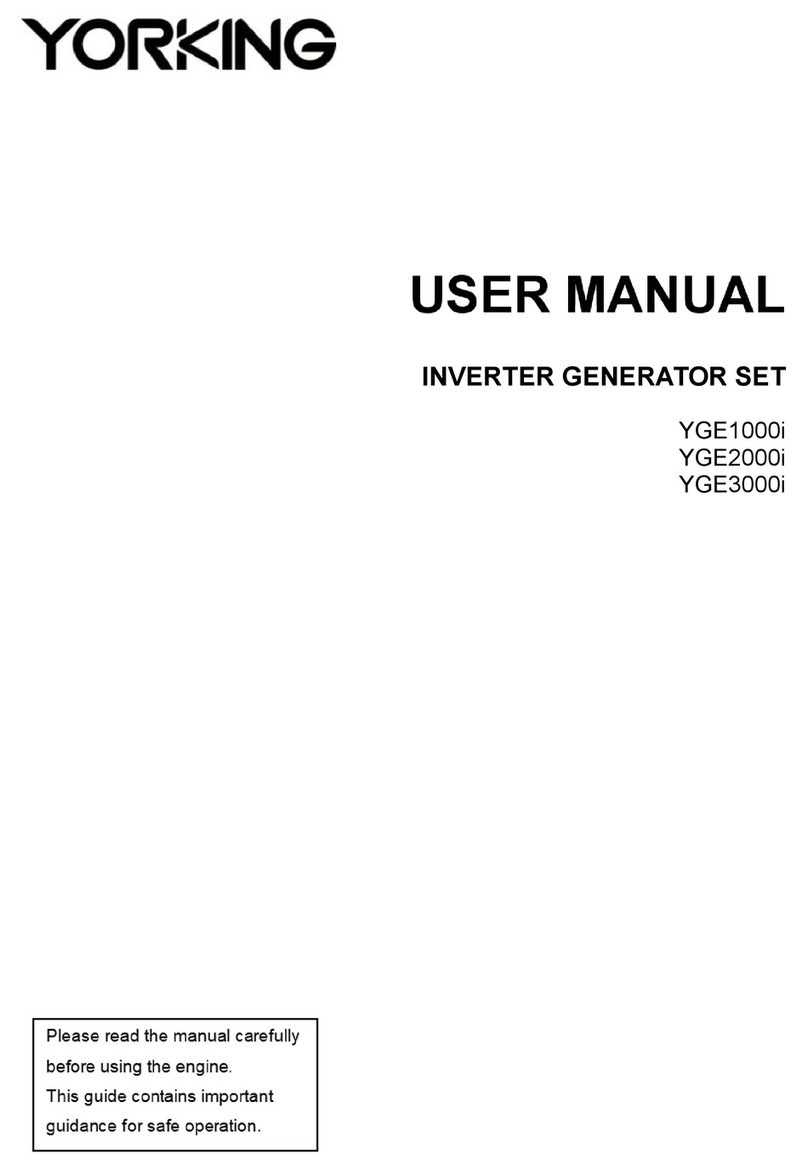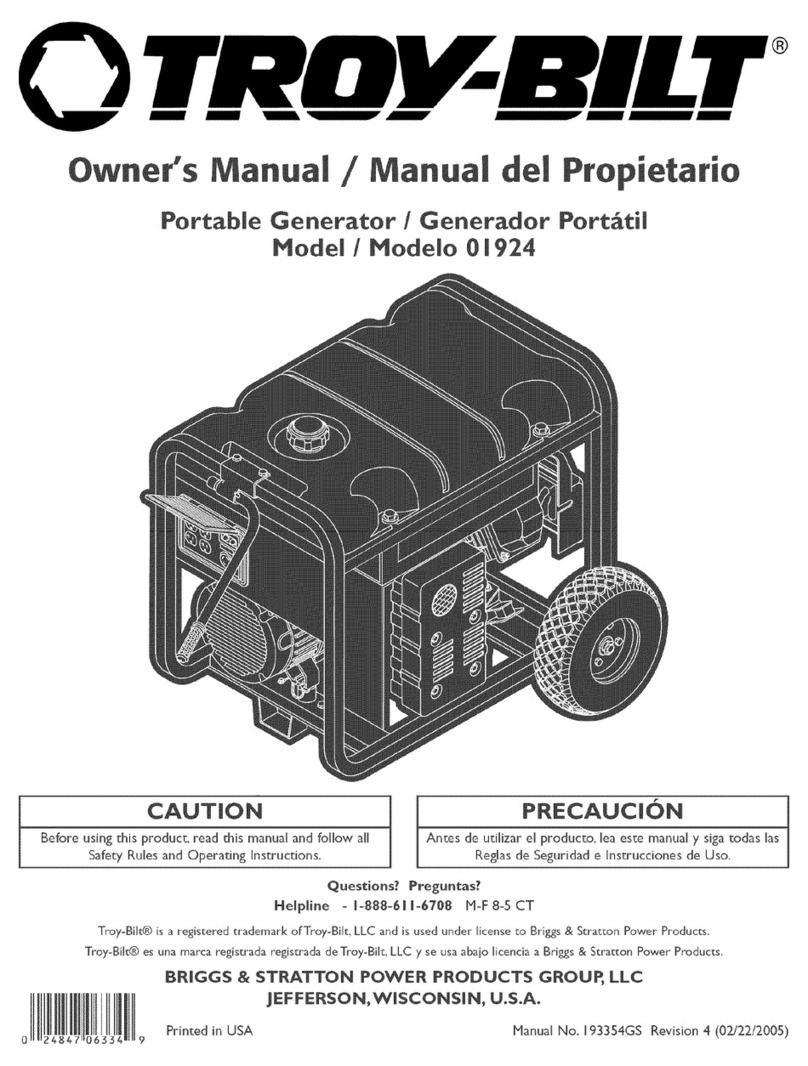Bavaria BPG 2500 User manual

kOriginalbetriebsanleitung
Stromerzeuger
tOriginal operating instructions
Generator
pMode d’emploi d’origine
Générateur de courant
CIstruzioni per l’uso originali
Gruppo elettrogeno
Bf Originalne upute za uporabu
Generator struje
4Originalna uputstva za upotrebu
Generator struje
PInstrukcją oryginalną
Generator prądotwórczy
QInstrucţiuni de utilizare originale
generator de curent
eОригинално упътване за употреба
Електрогенератор
ZOrijinal Kullanma Talimatı
Jeneratör
1Оригінальна інструкція з експлуатації
Генератор струму
AEredeti használati utasítás
Áramfejlesztő
HOriģinālā lietošanas instrukcija
Generators
GOriginali naudojimo instrukcija
Elektros generatorius
Art.-Nr.: 41.525.10 I.-Nr.: 11012 BPG 2500
Anleitung_BPG_2500_SPK7__ 17.04.13 11:18 Seite 1

2
1
2 3
9
7
7
12
10
4
8
12
65
6533 4
33
11 13
Anleitung_BPG_2500_SPK7__ 17.04.13 11:18 Seite 2

3
4 5
8
7
6
8
D
A
A
9
7
B
6
Anleitung_BPG_2500_SPK7__ 17.04.13 11:18 Seite 3

4
9
1
2
3
4
Anleitung_BPG_2500_SPK7__ 17.04.13 11:18 Seite 4

D
5
Achtung!
Beim Benutzen von Geräten müssen einige
Sicherheitsvorkehrungen eingehalten werden, um
Verletzungen und Schäden zu verhindern. Lesen Sie
diese Bedienungsanleitung deshalb sorgfältig durch.
Bewahren Sie diese gut auf, damit Ihnen die
Informationen jederzeit zur Verfügung stehen. Falls
Sie das Gerät an andere Personen übergeben
sollten, händigen Sie diese Bedienungsanleitung
bitte mit aus. Wir übernehmen keine Haftung für
Unfälle oder Schäden, die durch Nichtbeachten
dieser Anleitung und den Sicherheitshinweisen
entstehen.
Erklärung der Hinweisschilder auf dem Gerät
(Bild 9)
1. Achtung! Bedienungsanleitung lesen.
2. Achtung! Heiße Teile. Abstand halten.
3. Achtung! Während des Tankens Motor
abstellen.
4. Achtung! Nicht in unbelüfteten Räumen
betreiben.
1. Sicherheitshinweise
nEs dürfen keine Veränderungen am Stromer-
zeuger vorgenommen werden.
nEs dürfen für Wartung und Zubehör nur
Originalteile verwendet werden.
nAchtung: Vergiftungsgefahr, Abgase, Kraftstoffe
und Schmierstoffe sind giftig, Abgase dürfen
nicht eingeatmet werden.
nKinder sind vom Stromerzeuger fernzuhalten
nAchtung: Verbrennungsgefahr, Abgasanlage und
Antriebsaggregat nicht berühren
nBenutzen Sie einen geeigneten Gehörschutz,
wenn Sie sich in der Nähe des Gerätes befinden.
nAchtung: Benzin und Benzindämpfe sind leicht
entzündlich bzw. explosiv.
nDen Stromerzeuger nicht in unbelüfteten
Räumen oder in leicht entflammbarer Umgebung
betreiben. Wenn der Generator in gut belüfteten
Räumen betrieben werden soll, müssen die
Abgase über einen Abgasschlauch direkt ins
Freie geleitet werden. Achtung: Auch beim
Betrieb eines Abgasschlauches können giftige
Abgase entweichen. Wegen der Brandgefahr,
darf der Abgasschlauch niemals auf brennbare
Stoffe gerichtet werden.
nExplosionsgefahr: Den Stromerzeuger niemals in
Räumen mit leicht entzündlichen Stoffen
betreiben.
nDie voreingestellte Drehzahl des Herstellers darf
nicht verändert werden. Stromerzeuger oder
angeschlossene Geräte können beschädigt
werden.
nWährend des Transports ist der Stromerzeuger
gegen Verrutschen und Kippen zu sichern.
nDen Generator mindestens 1m entfernt von
Wänden oder angeschlossenen Geräten
aufstellen.
nDem Stromerzeuger einen sicheren, ebenen
Platz geben. Drehen und Kippen oder Standort-
wechsel während des Betriebes ist verboten.
nBeim Transport und Auftanken den Motor stets
abschalten.
nDarauf achten, dass beim Auftanken kein
Kraftstoff auf den Motor oder Auspuff verschüttet
wird.
nStromerzeuger niemals bei Regen oder
Schneefall betreiben.
nDen Stromerzeuger nie mit nassen Händen
anfassen
nSchützen Sie sich vor elektrischen Gefahren.
nVerwenden Sie im Freien nur dafür zugelassene
und entsprechend gekennzeichnete
Verlängerungskabel (H07RN..).
nBei Verwendung von Verlängerungsleitungen
darf deren Gesamtlänge für 1,5 mm250 m, für
2,5 mm2100 m nicht überschreiten.
nAn den Motor- und Generatoreinstellungen
dürfen keine Veränderungen vorgenommen
werden.
nReparatur- und Einstellarbeiten dürfen nur durch
autorisiertes Fachpersonal ausgeführt werden.
nNicht in der Nähe von offenem Licht, Feuer oder
Funkenflug betanken, bzw. den Tank entleeren.
Nicht rauchen!
nBerühren Sie keine mechanisch bewegten oder
heißen Teile. Entfernen Sie keine Schutzabdek-
kungen.
nDie Geräte dürfen keiner Feuchtigkeit oder Staub
ausgesetzt werden. Zulässige Umgebungs-
temperatur -10 bis +40°, Höhe: 1000 m über
NN, rel. Luftfeuchtigkeit: 90 % (nicht konden-
sierend)
nDer Generator wird von einem Verbrennungs-
motor angetrieben, der im Bereich des Auspuffes
(auf der gegenüber liegenden Seite der Steck-
dose) und Auspuffaustritts Hitze erzeugt. Meiden
Sie die Nähe dieser Oberflächen wegen der
Gefahr von Hautverbrennungen.
nBei den technischen Daten unter Schallleistungs-
pegel (LWA) und Schalldruckpegel (LpA)
angegebene Werte stellen Emissionspegel dar
und sind nicht zwangsläufig sichere Arbeits-
pegel. Da es einen Zusammenhang zwischen
Emissions- und Immissionspegeln gibt, kann
dieser nicht zuverlässig zur Bestimmung
eventuell erforderlicher, zusätzlicher Vorsichts-
Anleitung_BPG_2500_SPK7__ 17.04.13 11:18 Seite 5

maßnahmen herangezogen werden.
Einflussfaktoren auf den aktuellen Immissions-
pegel der Arbeitskraft schließen die Eigenschaf-
ten des Arbeitsraumes, andere Geräuschquellen,
etc., wie z.B. die Anzahl der Maschinen und
anderer angrenzender Prozesse und die Zeit-
spanne, die ein Bediener dem Lärm ausgesetzt
ist, ein. Ebenfalls kann der zulässige Immissions-
pegel von Land zu Land abweichen. Dennoch
wird diese Information dem Betreiber der
Maschine die Möglichkeit bieten, eine bessere
Abschätzung der Risiken und Gefährdungen
durchzuführen.
Achtung: Verwenden Sie ausschließlich
bleifreies Normal-Benzin als Kraftstoff.
WARNUNG
Lesen Sie alle Sicherheitshinweise und
Anweisungen. Versäumnisse bei der Einhaltung der
Sicherheitshinweise und Anweisungen können
elektrischen Schlag, Brand und/oder schwere
Verletzungen zur Folge haben.
Bewahren Sie alle Sicherheitshinweise und
Anweisungen für die Zukunft auf.
2. Gerätebeschreibung (Abb. 1-4)
1 Tankanzeige
2 Tankdeckel
3 2 x 230 V~ Steckdosen
4 Erdungsanschluss
5 Sicherheitsauslöser
6 Voltmeter
7 Öleinfüllschraube
8 Ölablassschraube
9 Ölmangelsicherung
10 Ein-/Ausschalter
11 Chokehebel
12 Reversierstarteinrichtung
13 Benzinhahn
3. Bestimmungsgemäße Verwendung
Das Gerät ist für Anwendungen, welche einen
Betrieb an einer 230 V Wechselspannungsquelle
vorsehen, geeignet. Beachten Sie unbedingt die
Einschränkungen in den Sicherheitshinweisen.
Zweck des Generators ist der Antrieb von
Elektrowerkzeugen und die Stromversorgung von
Beleuchtungsquellen. Bei Haushaltsgeräten prüfen
Sie bitte die Eignung nach den jeweiligen
Herstellerangaben. Fragen Sie im Zweifel einen
autorisierten Fachhändler des jeweiligen Gerätes.
Die Maschine darf nur nach ihrer Bestimmung
verwendet werden. Jede weitere darüber
hinausgehende Verwendung ist nicht
bestimmungsgemäß. Für daraus hervorgerufene
Schäden oder Verletzungen aller Art haftet der
Benutzer/Bediener und nicht der Hersteller.
Bitte beachten Sie, dass unsere Geräte
bestimmungsgemäß nicht für den gewerblichen,
handwerklichen oder industriellen Einsatz konstruiert
wurden. Wir übernehmen keine Gewährleistung,
wenn das Gerät in Gewerbe-, Handwerks- oder
Industriebetrieben sowie bei gleichzusetzenden
Tätigkeiten eingesetzt wird.
4. Technische Daten
Generator: Synchron
Schutzart: IP23M
Dauerleistung Pnenn (S1): 2000 W
Maximalleistung Pmax (S2 2 min): 2200 W
Nennspannung Unenn: 2 x 230V~
Nennstrom Inenn:9A
Frequenz Fnenn: 50 Hz
Bauart Antriebsmotor: 4 Takt luftgekühlt
Hubraum: 196 cm³
Max. Leistung: 4 kW / 5,4 PS
Kraftstoff: Benzin
Tankinhalt: 13 l
Motoröl: ca. 0,6 l (15W40)
Verbrauch bei 2/3 Last: ca. 1,63 l/h
Gewicht: 31,5 kg
Schalldruckpegel LpA: 75 dB(A)
Schallleistungspegel LWA/Unsicherheit K
95 dB (A)/3 dB(A)
Leistungsfaktor cos Ê: 1
Leistungsklasse: G1
Temperatur max: 40°C
Max. Aufstellhöhe (üNN): 1000 m
Zündkerze: NGK F6TC/F7TC
6
D
Anleitung_BPG_2500_SPK7__ 17.04.13 11:18 Seite 6

Betriebsart S1 (Dauerbetrieb)
Die Maschine kann dauerhaft mit der angegebenen
Leistung betrieben werden.
Betriebsart S2 (Kurzzeitbetrieb)
Die Maschine darf kurzzeitig mit der angegebenen
Leistung betrieben werden (2 min).
5. Vor Inbetriebnahme
5.1 Elektrische Sicherheit:
nelektrische Zuleitungen und angeschlossene
Geräte müssen in einem einwandfreien Zustand
sein.
nEs dürfen nur Geräte angeschlossen werden,
deren Spannungsangabe mit der
Ausgangsspannung des Stromerzeugers
übereinstimmt.
nNiemals den Stromerzeuger mit dem Stromnetz
(Steckdose) verbinden.
nDie Leitungslängen zum Verbraucher sind
möglichst kurz zu halten.
5.2 Umweltschutz
nverschmutztes Wartungsmaterial und
Betriebsstoffe in einer dafür vorgesehenen
Sammelstelle abgeben
nVerpackungsmaterial, Metall und Kunststoffe
dem Recycling zuführen.
5.3 Erdung
Zur Ableitung statischer Aufladungen ist eine Erdung
des Gehäuses nötig. Hierzu ein Kabel auf der einen
Seite am Erdungsanschluss des Generators (Abb.
3/Pos. 4) und auf der anderen Seite mit einer ex-
ternen Masse (z. B. Staberder) verbinden.
6. Bedienung
Achtung! Bei Erstinbetriebnahme muss Motorenöl
(ca. 0,6 l) und Kraftstoff eingefüllt werden.
nKraftstoffstand prüfen, eventuell nachfüllen
nFür ausreichende Belüftung des Geräts sorgen
nVergewissern Sie sich, dass das Zündkabel an
der Zündkerze befestigt ist
nDie unmittelbare Umgebung des Stromerzeugers
begutachten
nEventuell angeschlossenes elektrisches Gerät
vom Stromerzeuger trennen
6.1 Motor starten
nBenzinhahn (13) öffnen; hierfür den Hahn nach
unten drehen
nEin-/Ausschalter (10) auf Stellung “ON” bringen
nChokehebel (11) auf Stellung I Ø I bringen
nDen Motor mit dem Reversierstarter (12) starten;
hierfür am Griff kräftig anziehen. Sollte der Motor
nicht gestartet haben, nochmals am Griff
anziehen
nChokehebel (11) nach dem Starten des Motors
wieder zurückschieben.
Achtung!
Beim Starten mit dem Reservierstarter kann es durch
plötzlichen Rücksschlag, verursacht durch den an-
laufenden Motor, zu Verletzungen an der Hand kom-
men. Tragen Sie zum Starten Schutzhandschuhe.
6.2 Belasten des Stromerzeugers
nZu betreibende Geräte an die 230 V~
Steckdosen (3) anschließen
Achtung: Diese Steckdosen dürfen dauernd (S1) mit
2000W und kurzzeitig (S2) für max. 2 Minuten mit
2200W belastet werden.
nDer Stromerzeuger ist für 230 V~
Wechselspannungsgeräte geeignet
nDen Generator nicht an ein Haushaltsnetz
anschließen, dadurch kann eine Beschädigung
des Generators oder anderer Elektrogeräte im
Haus verursacht werden.
Hinweis: Manche Elektrogeräte (Motorstichsägen,
Bohrmaschinen usw.) können einen höheren
Stromverbrauch haben, wenn sie unter erschwerten
Bedingungen eingesetzt werden.
6.3 Motor abstellen
nDen Stromerzeuger kurz ohne Belastung laufen
lassen, bevor Sie ihn abstellen, damit das
Aggregat “nachkühlen” kann
nDen Ein- /Ausschalter (10) auf Stellung “OFF”
bringen
nDen Benzinhahn schließen.
Achtung! Der Stromerzeuger ist mit einem
Überlastungsschutz ausgestattet.
Dieser schaltet die Steckdosen (3) ab. Durch
Drücken des Überlastungsschutzes (5) können die
Steckdosen (3) wieder in Betrieb genommen werden.
Achtung! Sollte dieser Fall auftreten so
reduzieren Sie die elektrische Leistung, welche
Sie dem Stromerzeuger entnehmen oder
entfernen Sie defekte angeschlossene Geräte.
7
D
Anleitung_BPG_2500_SPK7__ 17.04.13 11:18 Seite 7

Achtung! Defekte Überlastschalter dürfen nur
durch baugleiche Überlastschalter mit gleichen
Leistungsdaten ersetzt werden. Wenden Sie sich
hierfür an Ihren Kundendienst.
7. Reinigung, Wartung und
Ersatzteilbestellung
Stellen Sie vor allen Reinigungs- und
Wartungsarbeiten den Motor ab und ziehen Sie den
Zündkerzenstecker von der Zündkerze.
Achtung: Stellen Sie das Gerät sofort ab und
wenden Sie sich an Ihre Service Station:
nBei ungewöhnlichen Schwingungen oder
Geräuschen
nWenn der Motor überlastet scheint oder
Fehlzündungen hat
7.1 Reinigung
nHalten Sie Schutzvorrichtungen, Luftschlitze und
Motorengehäuse so staub- und schmutzfrei wie
möglich. Reiben Sie das Gerät mit einem
sauberen Tuch ab oder blasen Sie es mit
Druckluft bei niedrigem Druck aus.
nWir empfehlen, dass Sie das Gerät direkt nach
jeder Benutzung reinigen.
nReinigen Sie das Gerät regelmäßig mit einem
feuchten Tuch und etwas Schmierseife.
Verwenden Sie keine Reinigungs- oder
Lösungsmittel; diese könnten die Kunststoffteile
des Gerätes angreifen. Achten Sie darauf, dass
kein Wasser in das Geräteinnere gelangen kann.
7.2 Luftfilter
Beachten Sie hierzu auch die Service-Informa-
tionen.
nLuftfilter regelmäßig reinigen, wenn nötig tau-
schen
nÖffnen Sie die beiden Klammern (Abb. 5/A) und
entfernen Sie den Luftfilterdeckel (Abb. 5/B)
nEntnehmen Sie die Filterelemente (Abb. 6/C)
nZum Reinigen der Elemente dürfen keine
scharfen Reiniger oder Benzin verwendet
werden.
nDie Elemente durch Ausklopfen auf einer flachen
Fläche reinigen. Bei starker Verschmutzung mit
Seifenlauge waschen, anschließend mit klarem
Wasser ausspülen und an der Luft trocknen las-
sen.
nDer Zusammenbau erfolgt in umgekehrter
Reihenfolge.
7.3 Zündkerze (Abb. 7)
Überprüfen Sie die Zündkerze erstmals nach 20
Betriebsstunden auf Verschmutzung und reinigen
Sie diese gegebenenfalls mit einer
Kupferdrahtbürste. Danach die Zündkerze alle 50
Betriebsstunden warten.
nZiehen Sie den Zündkerzenstecker (Abb. 7) mit
einer Drehbewegung ab.
nEntfernen Sie die Zündkerze (Abb. 8/D) mit dem
beiliegenden Zündkerzenschlüssel
nDer Zusammenbau erfolgt in umgekehrter
Reihenfolge
7.4 Ölwechsel, Ölstand prüfen (vor jedem
Gebrauch)
Der Motorölwechsel sollte bei betriebswarmen Motor
durchgeführt werden.
nNur Motorenöl (15W40) verwenden
nStromerzeugeraggregat auf geeigneter
Unterlage leicht schräg gegen die
Ölablassschraube abstellen.
nÖleinfüllschraube öffnen
nÖlablassschraube öffnen und warmes Motorenöl
in einen Auffangbehälter ablassen
nNach Auslaufen des Altöls Ölablassschraube
schließen und Stromerzeuger wieder eben auf-
stellen.
nMotoröl bis zur oberen Markierung des Ölmess-
stabs einfüllen (ca. 0,6 l).
nAchtung: Ölmessstab zum Prüfen des Ölstandes
nicht einschrauben sondern nur bis zum
Gewinde einstecken.
nDas Altöl muss ordentlich entsorgt werden.
7.5 Ölabschaltautomatik
Die Ölabschaltautomatik spricht an, wenn zu wenig
Motoröl vorhanden ist. Der Motor kann in diesem Fall
nicht gestartet werden oder stellt sich nach kurzer
Zeit automatisch ab. Ein Starten ist erst nach
Auffüllen von Motoröl (siehe Punkt 7.4) möglich.
7.6 Ersatzteilbestellung:
Bei der Ersatzteilbestellung sollten folgende
Angaben gemacht werden;
nTyp des Gerätes
nArtikelnummer des Gerätes
nIdent-Nummer des Gerätes
nErsatzteilnummer des erforderlichen Ersatzteils
Aktuelle Preise und Infos finden Sie unter
www.isc-gmbh.info
8
D
Anleitung_BPG_2500_SPK7__ 17.04.13 11:18 Seite 8

8. Entsorgung und Wiederverwertung
Das Gerät befindet sich in einer Verpackung um
Transportschäden zu verhindern. Diese Verpackung
ist Rohstoff und ist somit wieder verwendbar oder
kann dem Rohstoffkreislauf zurückgeführt werden.
Das Gerät und dessen Zubehör bestehen aus
verschiedenen Materialien, wie z.B. Metall und
Kunststoffe. Führen Sie defekte Bauteile der
Sondermüllentsorgung zu. Fragen Sie im
Fachgeschäft oder in der Gemeindeverwaltung nach!
D
9
9. Störungen beheben
Störung Ursache Maßnahme
Motor kann nicht gestartet werden Ölabschaltautomatik spricht an
Zündkerze verrußt
kein Kraftstoff
Ölstand prüfen, Motoröl auffüllen
Zündkerze reinigen, bzw.
tauschen. Elektrodenabstand
0,6 mm
Kraftstoff nachfüllen /
Benzinhahn überprüfen lassen
Generator hat zu wenig oder
keine Spannung
Regler oder Kondensator defekt
Überstromschutzschalter ausge-
löst
Luftfilter verschmutzt
Fachhändler aufsuchen
Schalter betätigen und Ver-
braucher verringern
Filter reinigen oder ersetzen
Anleitung_BPG_2500_SPK7__ 17.04.13 11:18 Seite 9

Important!
When using the equipment, a few safety precautions
must be observed to avoid injuries and damage.
Please read the complete operating instructions and
safety regulations with due care. Keep this manual in
a safe place, so that the information is available at all
times. If you give the equipment to any other person,
hand over these operating instructions and safety
regulations as well. We cannot accept any liability for
damage or accidents which arise due to a failure to
follow these instructions and the safety instructions.
Explanation of the warning signs on the machine
(Fig. 9)
1. Important. Read the operating instructions.
2. Important. Hot parts. Keep your distance.
3. Important. Switch off the engine before refueling.
4. Important. Never operate in non-ventilated rooms.
1. General safety instructions:
앬No changes may be made to the generator.
앬Only original parts may be used for maintenance
and accessories.
앬Important: Danger of poisoning, do not inhale
emissions.
앬Children are to be kept away from the generator.
앬Important: Risk of burns. Do not touch the
exhaust system or drive unit.
앬Wear suitable ear protection when in the vicinity
of the equipment.
앬Important: Petrol and petrol fumes are highly
combustible or explosive.
앬Never operate the generator in non-ventilated
rooms or in easyly inflammable adjacency. When
operating the generator in rooms with good venti-
lation, the exhaust gases must be channeled
directly outdoors through an exhaust hose.
Important: Toxic exhaust gases can escape
despite the exhaust hose. Due to the fire hazard,
never direct the exhaust hose towards
inflammable materials.
앬Risk of explosion: Never operate the generator in
rooms with combustible materials.
앬The speed preset by the manufacturer is not
allowed to be changed. The generator or
connected equipment may be damaged.
앬Secure the generator against shifting and
toppling during transport.
앬Place the generator at least 1m away from
buildings and the equipment connected to it.
앬Place the generator in a secure, level position.
Do not turn, tip or change the generator's
position while it is working.
앬Always switch off the engine when transporting
and refueling the generator.
앬Make sure that when you refuel the generator no
fuel is spilt on the engine or exhaust pipe.
앬Never operate the generator in rain or snow.
앬Never touch the generator with wet hands.
앬Guard against electric danger. When working
outdoors, use only extension cables that are
approved for outdoor use and which are marked
accordingly (H07RN..).
앬The overall length of the extension cables used
may not exceed 50 m for 1.5 mm2and 100 m for
2.5 m2.
앬No changes may be made to the settings of the
motor or generator.
앬Repairs and adjustment work may only be
carried out by authorized trained personnel.
앬Do not refuel or empty the tank near open lights,
fire or sparks. Do not smoke!
앬Do not touch any mechanically driven or hot
parts. Do not remove the safety guards.
앬Do not expose the tools to damp or dust.
Permissible ambient temperature – 10 to + 40
°C, max. altitude above sea level 1000 m,
relative humidity: 90 % (non-condensing)
앬The generator is driven by a combustion engine,
which produces heat in the area of the exhaust
(on the opposite side of the sockets) and the
exhaust outlet. You should therefore keep clear
of these surfaces because of risk of skin burns.
앬The values quoted in the technical data for
sound power level (LWA) and sound pressure
level (LWM) are emission values and not
necessarily reliable workplace values. As there
is a correlation between emission and immission
levels, the values are not a reliable basis for
deciding on any additional precautions which
may be needed. Factors influencing the actual
user immission level include the properties of the
work area, other sound sources etc., the number
of machines and other processes in the vicinity,
as well as the time span in which the operator is
subjected to the noise. Also, the permitted
immission level can vary from country to country.
Nevertheless, with this information the user is
able to make a better assessment of the dangers
and risks involved.
앬Never use a faulty or damaged electrical
equipment (this also applies to extension cables
and plug connections).
GB
10
Anleitung_BPG_2500_SPK7__ 17.04.13 11:18 Seite 10

GB
11
CAUTION!
Read all safety regulations and instructions.
Any errors made in following the safety regulations
and instructions may result in an electric shock, fire
and/or serious injury.
Keep all safety regulations and instructions in a
safe place for future use.
2. Layout (Fig. 1-4)
1 Tank indicator
2 Tank cover
3 2 x 230 V~ socket-outlets
4 Earth connection
5 Safety tripping element
6 Voltmeter
7 Oil filler plug
8 Oil drain plug
9 Oil shortage cut-out
10 On/Off switch
11 Choke lever
12 Reversing starter
13 Petrol cock
3. Proper use
The device is designed for applications operated with
a 230 V alternating current source. Be sure to
observe the restrictions in the safety instructions.
The generator is intended to provide electric tools
and light sources with electricity.
When using the device with household appliances,
please check their suitability in accordance with the
relevant manufacturerʼs instructions. In case of
doubt, ask an authorized dealer of the respective
appliance.
The machine is to be used only for its prescribed
purpose. Any other use is deemed to be a case of
misuse. The user / operator and not the
manufacturer will be liable for any damage or injuries
of any kind caused as a result of this.
Please note that our equipment has not been
designed for use in commercial, trade or industrial
applications. Our warranty will be voided if the
machine is used in commercial, trade or industrial
businesses or for equivalent purposes.
4. Technical data
Generator Synchronous
Protection type: IP23M
Continuous rated power Prated (S1): 2000 W
Maximum power Pmax (S2 2 min): 2200 W
Rated voltage Urated: 2 x 230V~
Rated current Irated:9A
Frequency Frated: 50 Hz
Drive engine design: 4-stroke, air-cooled
Displacement: 196 cm³
Max. power: 4 kW / 5,4 hp
Fuel: petrol
Tank capacity: 13 l
Engine oil: approx. 0.6 l (15W40)
Consumption at 2/3 load: approx. 1.63 l/h
Weight: 31,5 kg
Sound pressure level LpA: 75 dB(A)
Sound power level LWA/Uncertainty K:
95 dB (A)/3 dB(A)
Power factor cos ϕ: 1
Power class: G1
Max. temperature: 40°C
Max. altitude (above mean sea level): 1000 m
Spark plug: NGK F6TC/F7TC
Operating mode S1 (continuous operation)
The machine can be continuously operated with the
quoted power output.
Operating mode S2 (temporary operation)
The machine may be temporarily operated with the
quoted power output (2 min).
5. Before putting the machine into
operation
5.1 Electrical safety:
앬Electric supply cables and connected equipment
must be in perfect condition.
앬The generator is to be operated only with
equipment whose voltage specifications conform
with the generator's output voltage.
앬Never connect the generator to the power supply
(socket-outlet).
앬Keep the cable length to the consumer as short
as possible.
Anleitung_BPG_2500_SPK7__ 17.04.13 11:18 Seite 11

5.2 Environmental protection
앬Dispose of soiled maintenance material and
operating materials at the appropriate collection
point.
앬Recycle packaging material, metal and plastics.
5.3 Connecting to earth
The housing is allowed to be connected to earth in
order to discharge static electricity. To do this,
connect one end of a cable to the earth connection
on the generator (Fig. 4) and the other end to an
external earth (for example an earthing rod).
6. Operation
Important! You must fill up with engine oil (approx.
0.6 l) and fuel before you can start the engine.
앬Check the fuel level and top it up if necessary
앬Make sure that the generator has sufficient
ventilation
앬Make sure that the ignition cable is secured to
the spark plug
앬Inspect the immediate vicinity of the generator
앬Disconnect any electrical equipment which may
already be connected to the generator
6.1 Starting the engine
앬Open the petrol cock (13) by turning it down
앬Move the ON/OFF switch (10) to position "ON”
with the key.
앬Move the choke lever (11) to position IØI.
앬Start the engine with the reversing starter (12) by
pulling the handle forcefully. If the engine does
not start, pull the handle again.
앬Push the choke lever (11) back again after the
engine has started.
Important!
When starting with the reserve starter, the motor may
recoil suddenly as it starts up, resulting in hand
injuries. Wear protective gloves when starting the
equipment.
6.2 Connecting consumers to the generator
앬Connect the equipment you want to use to the
230 V~sockets (3)
Important: These sockets may be loaded
continuously (S1) with 2000W and temporarily (S2)
for a maximum of 2 minutes with 2200W.
앬The generator is suitable for 230 V~ AC
appliances.
앬Do not connect the generator to the domestic
power network as this may result in damage to
the generator itself or to other electrical
appliances in your home.
Note: Some electrical appliances (power jigsaws,
drills, etc.) may have a higher level of power
consumption when used in difficult conditions.
6.3 Switching off the engine
앬Before you switch off the generator, allow it to
run briefly with no consumers so that it can "cool
down”
앬Move the ON/OFF switch (10) to position "OFF”
with the key.
앬Close the petrol cock
Important! The generator is fitted with an
overload cut-out.
This shuts down the sockets (3). You can restart the
sockets (3) by pressing the overload cut-out (5).
Important! If this happens, reduce the electric
power you are taking from the generator or
remove any defective connected appliances.
Important! Defective overload cut-outs must be
replaced only by overload cut-outs of identical
design and with the same performance data. If
repairs are necessary, please contact your
customer service center.
7. Cleaning, maintenance, storage and
ordering of spare parts
Switch off the motor and pull the spark plug boot
from the spark plug before doing any cleaning and
maintenance work on the equipment.
Important: Switch off the machine immediately
and contact your service station:
앬In the event of unusual vibrations or noise
앬If the engine appears to be overloaded or
misfires
7.1 Cleaning
nKeep all safety devices, air vents and the motor
housing free of dirt and dust as far as possible.
Wipe the equipment with a clean cloth or blow it
with compressed air at low pressure.
nWe recommend that you clean the device
immediately each time you have finished using it.
GB
12
Anleitung_BPG_2500_SPK7__ 17.04.13 11:18 Seite 12

GB
13
nClean the equipment regularly with a moist cloth
and some soft soap. Do not use cleaning agents
or solvents; these could attack the plastic parts
of the equipment. Ensure that no water can seep
into the device.
7.2 Air filter
In this connection, please also read the service
information.
앬Clean the air filter at regular intervals, and replace
it if necessary.
앬Open both clips (Fig. 5/A) and remove the air filter
cover (Fig. 5/B).
앬Remove the filter elements (Fig. 6/C)
앬Do not use abrasive cleaning agents or petrol to
clean the elements.
앬Clean the elements by tapping them on a flat
surface. In cases of stubborn dirt first clean with
soapy water, then rinse with clear water and air-
dry.
앬Assemble in reverse order
7.3. Spark plug (Fig. 7)
Check the spark plug for dirt and grime after 20
hours of operation and if necessary clean with a
copper wire brush. Thereafter service the spark plug
after every 50 hours of operation.
앬Pull off the spark plug boot with a twist.
앬Remove the spark plug with the supplied spark
plug wrench.
앬Assemble in reverse order
7.4 Changing the oil and checking the oil level
(before using the machine)
The motor oil is best changed when the motor is at
working temperature.
앬Only use motor oil (15W40).
앬Place the generator on a slightly inclined surface
so that the oil drain plug is at the lower end.
앬Open the oil filler plug.
앬Open the oil drain plug and let the hot engine oil
drain out into a drip tray.
앬After the old oil has drained out, close the oil
drain plug and place the generator on a level
surface again
앬Fill in engine oil up to the top mark on the oil dip
stick (approx. 0.6 liters).
앬Important: Do not screw the dipstick in to check
the oil level, simply insert it up to the thread.
앬Dispose of the waste oil properly.
7.5 Automatic oil cut-out
The automatic oil cut-out responds if there is too little
oil in the engine. In this case it will not be possible to
start the engine or it will cut out automatically after a
short period of time. It cannot be started again until
the engine oil has been topped up (see point 7.4).
7.6 Ordering replacement parts:
Please quote the following data when ordering
replacement parts:
nType of machine
nArticle number of the machine
nIdentification number of the machine
nReplacement part number of the part required
For our latest prices and information please go to
www.isc-gmbh.info
8. Disposal and recycling
The unit is supplied in packaging to prevent its being
damaged in transit. This packaging is raw material
and can therefore be reused or can be returned to
the raw material system.
The unit and its accessories are made of various
types of material, such as metal and plastic.
Defective components must be disposed of as
special waste. Ask your dealer or your local council.
Anleitung_BPG_2500_SPK7__ 17.04.13 11:18 Seite 13

GB
9. Troubleshooting
Fault Cause Remedy
Engine does not start Automatic oil cut-out has not
responded
Spark plug fouled
No fuel
Check oil level, top up engine oil
Clean or replace spark plug
(electrode spacing 0.6 mm)
Refuel / have the petrol cock
checked
Generator has too little or no
voltage
Controller or capacitor defective
Overcurrent circuit-breaker has
triggered
Air filter dirty
Contact your dealer
Actuate the circuit-breaker and
reduce the consumers
Clean or replace the filter
14
Anleitung_BPG_2500_SPK7__ 17.04.13 11:18 Seite 14

F
Attention !
Lors de lʼutilisation dʼappareils, il faut respecter
certaines mesures de sécurité afin dʼéviter des
blessures et dommages. Veuillez donc lire
attentivement ce mode dʼemploi/ces consignes de
sécurité. Veillez à le conserver en bon état pour
pouvoir accéder aux informations à tout moment. Si
lʼappareil doit être remis à dʼautres personnes, veillez
à leur remettre aussi ce mode dʼemploi/ces
consignes de sécurité. Nous déclinons toute
responsabilité pour les accidents et dommages dus
au non-respect de ce mode dʼemploi et des
consignes de sécurité.
Explication des plaques signalétiques situées
sur lʼappareil (figure 9)
1. Attention ! Lisez le mode dʼemploi.
2. Attention ! Pièces brûlantes. Restez à distance.
3. Attention ! Mettez le moteur hors circuit pendant
que vous refaites le plein.
4. Attention ! Nʼutilisez pas lʼappareil dans des
endroits fermés.
1. Recommandations générales
concernant la sécurité
앬Aucune modification ne doit être entreprise sur le
générateur de courant.
앬Seules les pièces dʼorigine doivent être
employées pour la maintenance et les
accessoires.
앬Attention : danger dʼempoisonnement, les gaz
dʼéchappement ne doivent pas être respirés.
앬Il faut éloigner les enfants du générateur de
courant
앬Attention : risque de brûlure, ne touchez pas le
système de gaz dʼéchappement, ni le groupe
dʼentraînement
앬Utilisez un casque anti-bruit, lorsque vous vous
trouvez à proximité de lʼappareil.
앬Attention : Lʼessence et les vapeurs dʼessence
sont très inflammables et explosives.
앬Ne faites jamais fonctionner le générateur de
courant dans un endroit non aéré. Lors du
fonctionnement dans un endroit bien aéré, les
gaz dʼéchappement doivent être directement
évacués dehors en passant par un tuyau
dʼéchappement.
앬Attention : Attention : Attention : Attention:
même lors du fonctionnement avec un tuyau
dʼéchappement, des gaz dʼéchappement
toxiques peuvent sʼéchapper. à cause du risque
dʼincendie, le tuyau dʼéchappement ne doit
jamais être dirigé sur des matières combustibles.
앬Danger dʼexplosion : ne mettez pas le
générateur de courant en circuit dans un endroit
comprenant des substances très inflammables.
앬Le régime préréglé par le fabricant ne doit pas
être modifié. Le générateur de courant ou les
appareils raccordés peuvent être endommagés.
앬Pendant le transport, il faut sʼassurer que le
générateur de courant ne glisse ni ne se
renverse pas.
앬Positionnez le générateur à une distance de 1m
au minimum des bâtiments ou appareils
raccordés.
앬Donnez une place sûre et plane au générateur
de courant. Il est interdit de le tourner, de le
renverser ou même de le changer de place
pendant le fonctionnement !
앬Mettez toujours le moteur hors circuit pour le
transporter ou remplir le réservoir.
앬Veillez à ne pas renverser de carburant sur le
moteur ou lʼéchappement pendant le
remplissage.
앬Nʼexploitez pas le générateur de courant lorsquʼil
pleut ou quʼil neige.
앬Ne touchez jamais le générateur de courant avec
les mains mouillées
앬Protégez-vous contre les risques liés à
l'électricité. Utilisez en plein air seulement des
rallonges admises pour cela et dûment
caractérisées (H07RN).
앬Si vous utilisez des rallonges de câbles, la lon
gueur totale pour 1,5 mm2 ne doit pas dépasser
50 m, pour 2,5 mm2, 100 m.
앬Il ne faut modifier en aucun cas les réglages de
moteur et de générateur.
앬Les travaux de réparations et de réglage doivent
exclusivement être effectués par un personnel
spécialisé dûment autorisé.
앬Ne pas ravitailler ni vidanger à proximité de
lumière sans protection, de feu ou d'étincelles.
Ne pas fumer !
앬Ne toucher aucune pièce déplacée
mécaniquement ou chaude. Ne retirer aucun
recouvrement de protection.
앬Les appareils ne doivent pas être soumis à
l'humidité et la poussière. Température ambiante
admise -10 à +40°, altitude max. 1000 m,
humidité de l'air rel. : 90 % (ne condensant pas)
앬Ce générateur est entraîné par un moteur à
combustion qui génère de la chaleur dans la
zone du pot d'échappement (côté opposé à
celui de la prise) et de sa sortie. Evitez de vous
tenir à proximité de ces surfaces à cause du
risque de brûlures.
앬Les niveaux d'émission sont représentés dans
les caractéristiques techniques sous les valeurs
données des niveaux acoustiques (LWA) et de
15
Anleitung_BPG_2500_SPK7__ 17.04.13 11:18 Seite 15

pression acoustique (LWM) et ne sont pas
nécessairement des niveaux de travail sûrs.
Etant donné qu'il existe un lien entre les niveaux
d'émission et d'immission, celui-ci ne peut être
mis à contribution de façon fiable pour la
disposition de mesures de précautions
éventuellement nécessaires et supplémentaires.
Les facteurs qui influencent le niveau
d'immission actuel de la main dʼoeuvre
comprennent les propriétés de l'espace de
travail, d'autres sources de bruit, etc., comme
par ex. le nombre de machines et d'autres
processus limitrophes et la période pendant
laquelle un(e) opérateur/ opératrice est
soumis(e) au bruit. Le niveau d'immission
admissible peut également varier de pays à
pays. Cette information permettra toutefois à
l'exploitant de la machine de mieux évaluer les
risques et dangers.
앬Nʼutilisez aucun matériel dʼexploitation électrique
(même câbles de rallonge et connecteurs
enfichables) défectueux.
AVERTISSEMENT !
Veuillez lire toutes les consignes de sécurité et
instructions.
Tout non-respect des consignes de sécurité et
instructions peut provoquer une décharge électrique,
un incendie et/ou des blessures graves.
Conservez toutes les consignes de sécurité et
instructions pour une consultation ultérieure.
2. Description de l’appareil (figure 1-4)
1 Jauge de carburant
2 Couvercle du réservoir
3 2 prises de courant 230 V~
4 Raccordement de mise à la terre
5 Interrupteur de sécurité
6 Voltmètre
7 Vis de remplissage d’huile
8 Vis de purge d’huile
9 Dispositif de sécurité en cas de manque d’huile
10 Interrupteur Marche/Arrêt
11 Levier étrangleur
12 Dispositif de démarrage réversible
13 Robinet d’essence
3. Utilisation conforme à lʼaffectation
Cet appareil convient à toutes les applications
prévues pour un fonctionnement avec une source de
tension alternative de 230 V. Veuillez absolument
respecter les limites indiquées dans les consignes de
sécurité. Le but de ce générateur est lʼentraînement
dʼoutils électriques et lʼalimentation électrique de
sources dʼéclairage.
Vérifiez bien lʼaptitude des appareils ménagers
conformément aux indications du producteur. En cas
de doute, adressez-vous à un distributeur
professionnel dûment autorisé pour lʼappareil en
question.
La machine doit exclusivement être employée
conformément à son affectation. Chaque utilisation
allant au-delà de cette affectation est considérée
comme non conforme. Pour les dommages en
résultant ou les blessures de tout genre, le
producteur décline toute responsabilité et
lʼopérateur/lʼexploitant est responsable.
Veillez au fait que nos appareils, conformément à
leur affectation, nʼont pas été construits, pour être
utilisés dans un environnement professionnel,
industriel ou artisanal. Nous déclinons toute
responsabilité si lʼappareil est utilisé
professionnellement, artisanalement ou dans des
sociétés industrielles, tout comme pour toute activité
équivalente.
4. Données techniques
Générateur: synchrone
Type de protection : IP23M
Puissance continue Pnenn (S1) : 2000 W
Puissance maximale Pmax (S2 2 min) : 2200 W
Tension assignée Unenn : 2 x 230 V~
Courant nominal Inenn :9A
Fréquence Fnenn : 50 Hz
Type de construction du moteur d’entraînement :
4 temps refroidi par air
Cylindrée : 196 cm³
Puissance maxi : 4 KW / 5,4 CV
Carburant : essence sans plomb normale
Contenance du réservoir : 13 l
Huile moteur : env. 0,6 l (15W40)
Consommation à 2/3 de la charge : env. 1,63 l/h
Poids : 31,5 kg
F
16
Anleitung_BPG_2500_SPK7__ 17.04.13 11:18 Seite 16

F
17
Niveau de pression acoustique LpA : 75 dB(A)
Niveau de puissance acoustique LWA/incertitude K
95 dB (A)/3 dB(A)
Coefficient de puissance cos ϕ : 1
Classe de puissance : G1
Température maxi : 40°C
Hauteur d’installation maxi (üNN) : 1000 m
Bougie d’allumage : NGK F6TC/F7TC
Mode S1 (fonctionnement continu)
La machine peut être exploitée durablement à la
puissance indiquée.
Mode S2 (fonctionnement bref)
La machine peut être exploitée brièvement à la
puissance indiquée (2 min).
5. Avant la mise en service
5.1 Sécurité électrique
앬les câbles dʼalimentation électriques et les
appareils raccordés doivent être dans un état
irréprochable.
앬Seuls des appareils dont lʼindication de tension
correspond à la tension de sortie du générateur
de courant peuvent être raccordés.
앬Ne raccordez jamais le générateur de courant au
réseau de courant (prise de courant).
앬Les longueurs de câble au récépteur doivent être
les plus courtes possibles.
5.2 Protection de lʼenvironnement
앬Eliminez le matériel dʼentretien encrassé et les
carburants usagés dans les dépôts prévus à cet
effet
앬Recyclez le matériel dʼemballage, le métal et les
matières plastiques.
5.3 Mise à la terre
Pour dériver les charges statiques, il est permis de
mettre le boîtier à la terre. Pour ce faire, raccordez
un câble dʼun côté au branchement de terre du
générateur (fig. 4) et de lʼautre à une masse externe
(p. ex. barrette de terre).
6. Commande
Attention ! Lors de la première mise en service, il
faut avoir fait le plein de lubrifiant pour moteur (env.
0,6l) et de carburant.
앬Contrôlez le niveau de carburant, remplissez
éventuellement
앬Assurez-vous de la bonne aération de lʼappareil
앬Assurez-vous que le câble dʼallumage est fixé à la
bougie dʼallumage
앬Inspectez lʼenvironnement direct du générateur de
courant
앬Débranchez le matériel électrique éventuellement
raccordé au générateur de courant
6.1 Lancez le moteur
앬Ouvrez le robinet dʼessence (13) ; pour cela,
tournez le robinet vers le bas
앬Mettre l'interrupteur Marche / Arrêt (10) avec la
clé en position "ON"
앬Mettez le levier de starter (11) sur la position IØI.
앬Lancez le moteur avec le starter réversible (12) ;
pour cela, tirez très fort sur la poignée, si le
moteur ne démarre pas, tirez encore sur la
poignée
앬Repoussez le levier étrangleur (11) après le
démarrage du moteur
Attention !
Lors du démarrage avec le démarreur, le moteur qui
démarre peut provoquer un retour soudain et des
blessures au niveau de la main. Portez des gants de
protection pour le démarrage.
6.2 Charge du générateur de courant
앬Branchez les appareils à faire fonctionner aux
prises de courant à 230 V~ (3)
Attention : les prises de courant peuvent être
soumises à des sollicitations continues (S1) de 2000
W et brèves (S2) de 2200 W pendant une durée maxi.
de 2 minutes.
앬Le générateur de courant convient aux appareils
à tension alternative 230 V ~
앬Ne connectez pas le générateur au réseau
domestique, cela pourrait entraîner un
endommagement du générateur ou d'autres
appareils dans la maison.
Remarque : Certains appareils électriques (scies à
guichet à moteur, perceuses, etc.) peuvent
consommer plus de courant lorsqu'ils sont utilisés
sous des conditions difficiles.
Anleitung_BPG_2500_SPK7__ 17.04.13 11:18 Seite 17

6.3 Eteindre le moteur
앬Faites fonctionner le générateur de courant
brièvement sans charge avant de l'arrêter afin
que le groupe puisse "refroidir".
앬Mettez l'interrupteur Marche/Arrêt (10) avec la
clé en position "OFF"
앬Fermez le robinet dʼessence.
Attention ! Le générateur de courant est équipé
d’une protection contre les surcharges.
Celui-ci déconnecte la prise (3). En appuyant sur la
protection contre les surcharges (5), les prises de
courant (3) peuvent à nouveau être mises en service.
Attention ! Dans un tel cas, réduisez la puissance
électrique que vous soutirez du générateur de
courant ou supprimez les appareils défectueux
connectés.
Attention ! Les interrupteurs de surcharge
défectueux doivent uniquement être remplacés
par des interrupteurs de surcharge dont les
caractéristiques de puissance sont identiques.
Veuillez à ce propos vous adresser à votre
service après vente.
7. Nettoyage, maintenance, stockage
et commande de pièces de
rechange
Arrêtez le moteur avant tous travaux de nettoyage et
de maintenance et tirez la bougie dʼallumage de sa
cosse.
Attention : arrêtez immédiatement lʼappareil et
faite appel à votre service après vente :
앬lors de vibrations ou de bruits inhabituels
앬lorsque le moteur semble être surchargé ou quʼil
présente des défauts dʼallumage
7.1 Nettoyage
nMaintenez les dispositifs de protection, les fentes
à air et le carter de moteur aussi propres (sans
poussière) que possible. Frottez lʼappareil avec
un chiffon propre ou soufflez dessus avec de lʼair
comprimé à basse pression.
nNous recommandons de nettoyer lʼappareil
directement après chaque utilisation.
nNettoyez lʼappareil régulièrement à lʼaide dʼun
chiffon humide et un peu de savon. Nʼutilisez
aucun produit de nettoyage ni détergeant ; ils
pourraient endommager les pièces en matières
plastiques de lʼappareil. Veillez à ce quʼaucune
eau nʼentre à lʼintérieur de lʼappareil.
7.2 Filtre à air
Veuillez également respecter à ce propos les
informations du service après-vente.
앬Nettoyez régulièrement le filtre à air, si nécessaire
le remplacer
앬Ouvrez les deux agrafes (fig.5/A) et retirez le
couvercle du filtre à air (fig.5/B)
앬Enlevez les éléments filtrants (fig. 6/C)
앬Pour le nettoyage des éléments, n’utilisez pas de
nettoyant corrosif ni d’essence !
앬Nettoyez les éléments en les tapotant sur une
surface plane. En cas d’encrassement important
lavez-les avec de l’eau de savon, puis rincez à
l’eau claire et laisser sécher à l’air.
앬Le montage est effectué dans l’ordre inverse des
étapes.
7.3 Bougie dʼallumage (fig. 7)
Contrôlez la bougie dʼallumage pour la première fois
au but de 20 heures de service. Repérez les
encrassements et nettoyez-les le cas échéant à
lʼaide dʼune brosse à fils de cuivre. Effectuez ensuite
une maintenance de la bougie dʼallumage toutes les
50 heures de service.
앬Retirez la cosse de bougie dʼallumage (fig. 7)
dʼun mouvement rotatif.
앬Enlevez la bougie dʼallumage (fog- 8/D) à lʼaide
de la clé à bougie jointe.
앬Le montage sʼeffectue dans lʼordre inverse
7.4 Vidange d’huile / contrôle du niveau d’huile
(avant chaque utilisation)
Le changement d’huile du moteur doit se faire lorsque
le moteur est à température de service.
앬N’utilisez que des huiles moteur (15W40)
앬Posez le module du générateur de courant sur un
support adéquat, légèrement en biais par rapport
à la vis de purge d’huile.
앬Ouvrez la vis de remplissage d’huile
앬Ouvrez le bouchon de vidange d’huile et faire
couler huile chaude pour moteur dans un bac de
réception.
앬Après avoir vidangé l’huile usée, fermez le
bouchon de vidange d’huile et remettez le
générateur de courant à plat.
앬Remplir d’huile pour moteur jusqu’au repère
supérieur de la jauge de niveau d’huile (env. 0,6
L).
앬Attention : ne vissez pas la jauge de niveau
d’huile pour le contrôle du niveau d’huile, mais
enfoncez-la uniquement jusqu’au filet.
앬Il faut éliminer convenablement l’huile usée.
F
18
Anleitung_BPG_2500_SPK7__ 17.04.13 11:18 Seite 18

F
19
7.5 Système de mise hors circuit automatique à
cause de l’huile
Le système de mise hors circuit automatique à cause
de l’huile se déclenche lorsque le niveau d’huile dans
le moteur est trop bas. Il est donc impossible de faire
démarrer le moteur dans ce cas ou il se remet hors
circuit automatiquement au bout d’un bref délai. Ce
n’est qu’après avoir rempli huile pour moteur qu’un
démarrage est possible (voir repère 7.4).
7.6 Commande de pièces de rechange :
Pour les commandes de pièces de rechange,
veuillez indiquer les références suivantes:
nType de lʼappareil
nNo. dʼarticle de lʼappareil
nNo. dʼidentification de lʼappareil
nNo. de pièce de rechange de la pièce requise
Vous trouverez les prix et informations actuelles à
lʼadresse www.isc-gmbh.info
8. Mise au rebut et recyclage
Lʼappareil se trouve dans un emballage permettant
dʼéviter les dommages dus au transport. Cet
emballage est une matière première et peut donc
être réutilisé ultérieurement ou être réintroduit dans
le circuit des matières premières.
Lʼappareil et ses accessoires sont en matériaux
divers, comme par ex. des métaux et matières
plastiques. Eliminez les composants défectueux
dans les systèmes dʼélimination des déchets
spéciaux. Renseignez-vous dans un commerce
spécialisé ou auprès de lʼadministration de votre
commune !
9. Dépannages
Dérangement Origine Mesure
Le moteur ne peut pas être
démarré
La mise hors circuit automatique de
l’huile se déclenche
Bougie d’allumage encrassée
Panne de carburant
Contrôlez le niveau d’huile,
remplissez d’huile moteur
Nettoyez la bougie d’allumage ou
remplacez-la. Distance entre
électrodes 0,6 mm
Remplissez de carburant / faites
contrôler le robinet d’essence
Le générateur n’a pas assez de
tension ou n’en a pas du tout
Régulateur ou condensateur
défectueux
Protection contre les surcharges
déclenchée
Filtre à air encrassé
Consultez un spécialiste
Actionner l’interrupteur et diminuer
le consommateur
Nettoyez ou remplacez le filtre
Anleitung_BPG_2500_SPK7__ 17.04.13 11:18 Seite 19

Attenzione!
Nellʼusare gli apparecchi si devono rispettare diverse
avvertenze di sicurezza per evitare lesioni e danni.
Quindi leggete attentamente queste istruzioni per
lʼuso/le avvertenze di sicurezza. Conservate bene le
informazioni per averle a disposizione in qualsiasi
momento. Se date lʼapparecchio ad altre persone,
consegnate queste istruzioni per lʼuso/le avvertenze
di sicurezza insieme allʼapparecchio. Non ci
assumiamo alcuna responsabilità per incidenti o
danni causati dal mancato rispetto di queste
istruzioni e delle avvertenze di sicurezza.
Spiegazione delle targhette di avvertenze
sullʼapparecchio (Fig. 9)
1. Attenzione! Leggete le istruzioni per lʼuso.
2. Attenzione! Parti molto calde. Tenetevi a
distanza.
3. Attenzione! Spegnete il motore durante il
rifornimento.
4. Attenzione! Non mettete in funzione in locali
non arieggiati.
1. Avvertenze generali di sicurezza
앬Non si devono effettuare modifiche al gruppo
elettrogeno.
앬Per la manutenzione e come accessori si devono
utilizzare solo pezzi originali.
앬Attenzione: pericolo di avvelenamento, i gas di
scarico non devono essere inalati.
앬Tenete i bambini lontani dal gruppo elettrogeno.
앬Attenzione: pericolo di ustioni, non toccate lʼimpi
anto di scarico e il gruppo motore.
앬Utilizzate delle cuffie antirumore adeguate
quando siete nelle vicinanze dellʼapparecchio.
앬Attenzione: la benzina e i vapori della benzina
sono infiammabili ovvero esplosivi.
앬Non utilizzate mai il gruppo elettrogeno in locali
non areati. In caso di impiego in locali ben areati,
i gas di scarico devono essere condotti
direttamente allʼaperto mediante un tubo
flessibile di scarico.
앬Attenzione: anche usando un tubo flessibile di
scarico possono fuoriuscire gas tossici. A causa
del pericolo di incendio, il tubo di scarico non
deve essere mai indirizzato verso sostanze
infiammabili.
앬Pericolo dʼesplosione: non utilizzate mai il
gruppo elettrogeno in locali con sostanze
facilmente infiammabili.
앬Non si deve modificare il numero di giri preim
postato dal produttore. Si potrebbe danneggiare
il gruppo elettrogeno o gli apparecchi collegati.
앬Durante il trasporto si deve assicurare il gruppo
elettrogeno contro lo scivolamento e il
ribaltamento.
앬Installate il generatore a una distanza di almeno
1 m da edifici o apparecchi collegati.
앬Mettete il generatore di corrente in un posto
sicuro e piano. È vietato capovolgerlo, ribaltarlo
o spostarlo durante lʼesercizio.
앬Spegnete sempre il motore durante il trasporto o
il rifornimento di benzina.
앬Fate attenzione che durante il rifornimento non
sia versata della benzina sul motore o
sullʼimpianto di scarico.
앬Non usate mai i gruppi elettrogeni se piove o
nevica.
앬Non toccate mai il gruppo elettrogeno con le
mani bagnate.
앬Proteggetevi dai pericoli derivanti dalla corrente
elettrica. Usate all'aperto solo i cavi di prolunga
omologati per questo e contrassegnati in modo
corrispondente (H07RN.).
앬Nell'usare cavi di prolunga non si deve superare
una lunghezza totale di 50 m in caso di sezione
di 1,5 mm2e 100 m in caso di 2,5 mm2.
앬Non si devono eseguire modifiche alle
installazioni del motore e del generatore.
앬l lavori di riparazione e di regolazione devono
essere eseguiti solo da tecnici autorizzati.
앬Non riempite o svuotate il serbatoio nelle vicinan-
ze di fiamme vive, fuoco o scintille. Non fumare!
앬Non toccate parti mosse meccanicamente o
molto calde. Non togliete nessuna copertura di
protezione.
앬Gli apparecchi non devono essere esposti ad
umidità o polvere. Temperatura ambiente
consentita da -10 a +40°C, altitudine max. sul
livello del mare di 1000 m, umidità relativa
dell'aria: 90% (senza formazione di condensa).
앬Il generatore viene azionato da un motore a
combustione che produce calore nellʼarea dello
scappamento (sulla parte opposta alle prese di
corrente) e della sua parte finale. Evitate la
vicinanza a queste superfici visto il pericolo di
ustioni cutanee.
앬I valori indicati nelle caratteristiche tecniche per il
livello di potenza acustica (LWA) ed il livello di
pressione acustica (LWM) rappresentano dei
livelli di emissione e non necessariamente dei
livelli sicuri di lavoro. Dato che non c'è relazione
fra il livello di emissione e quello di immissione,
non è possibile usarlo in modo affidabile per
determinare la necessità di altre eventuali misure
cautelative. Tra i fattori che influiscono su livello
effettivo del livello di immissione per gli operatori
ci sono le caratteristiche dell'ambiente di lavoro,
altre fonti di rumore ecc. come per es. il numero
I
20
Anleitung_BPG_2500_SPK7__ 17.04.13 11:18 Seite 20
This manual suits for next models
2
Table of contents
Languages:
Popular Portable Generator manuals by other brands

Anritsu
Anritsu MG3700A MG3700A Operation manual
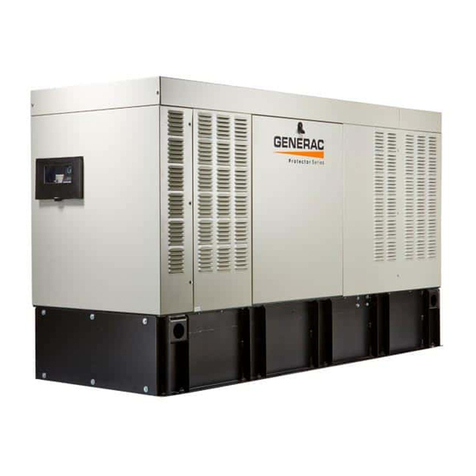
Generac Power Systems
Generac Power Systems RD015 owner's manual
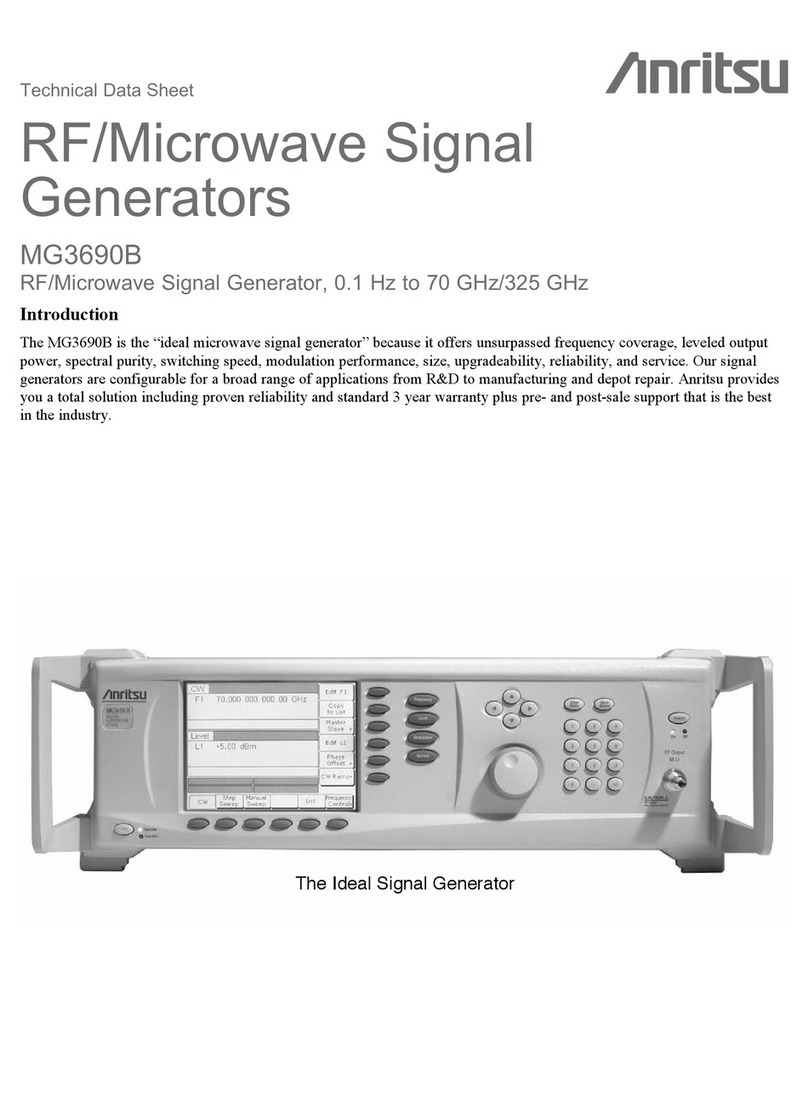
Anritsu
Anritsu MG3690B Technical data sheet
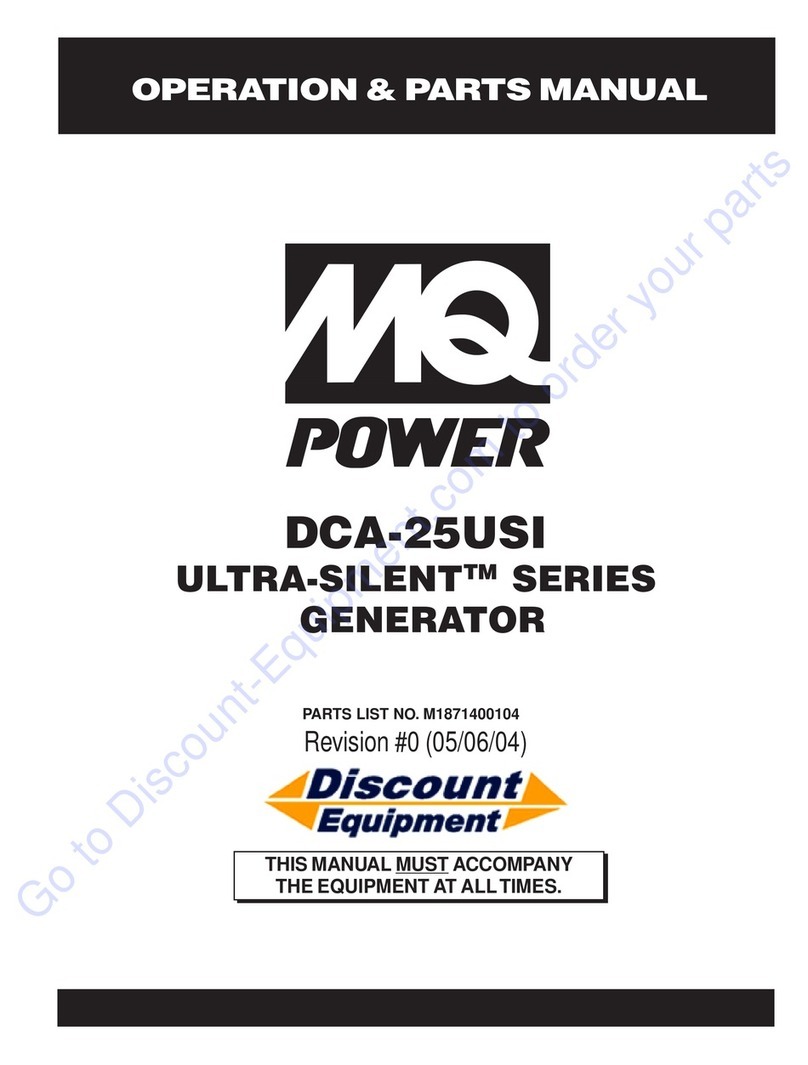
MQ Power
MQ Power ULTRA-SILENT DCA-25USI Series Operations & parts manual
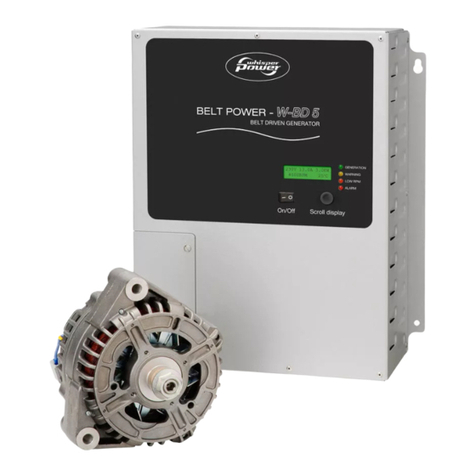
WhisperPower
WhisperPower Belt Power W-BD 3.5 user manual
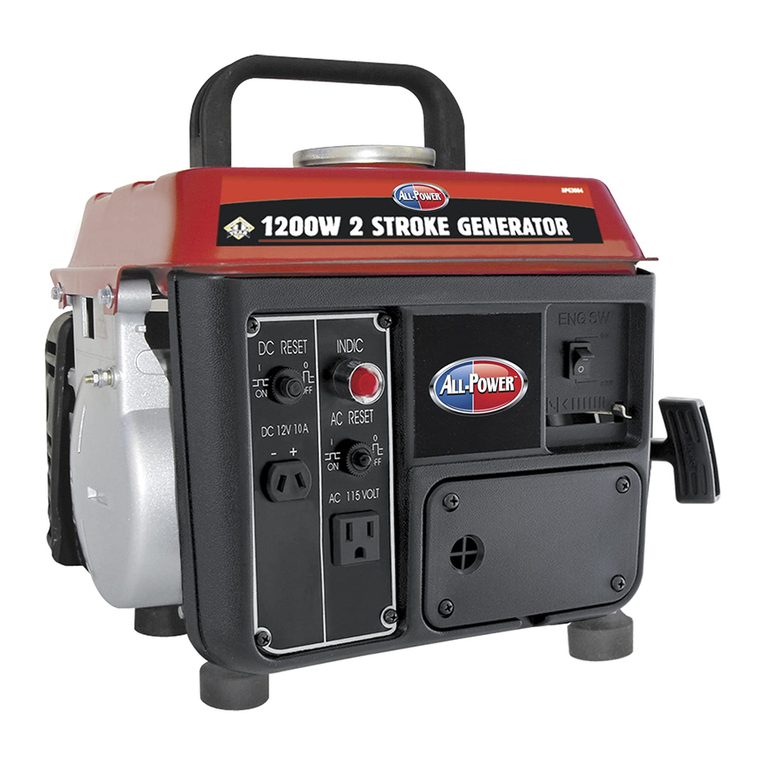
ALLPOWER
ALLPOWER APG3004D owner's manual
